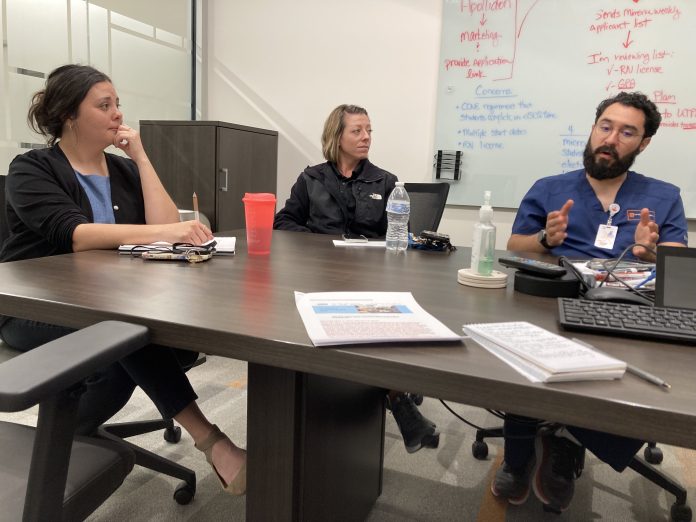
With an eye toward better patient outcomes, University of Texas Permian Basin is teaching students in different specialties to work as a team with older patients.
By 2034, adults will outnumber children for the first time in United States history so with that in mind, University of Texas Permian Basin College of Health Sciences and Human Performance has begun tackling the issue.
The U.S. Census Bureau in 2034 predicts that older adults will “edge out children in population size.” People age 65 and over are expected to reach 77 million while children under age 18 will number 76.5 million, according to Census Bureau information.
The information notes that this is not only happening in the U.S. but other countries like Japan an, Germany, Italy, France and Spain. Eastern European countries are further along and within a few years many of their populations are projected to begin shrinking.
“America has been different until now. Higher fertility and more international migration have helped stave off an aging population and the country has remained the youngest as a result. But those trends are changing. Americans are having fewer children and the baby boom of the 1950s and 1960s has not been repeated. Fewer babies, coupled with longer life expectancy equals a country that ages faster,” the information says.
Minvera Gonzales, UTPB interim nursing program director and associate dean for the College of Health Sciences and Human Performance, said within the American Association of Colleges of Nursing there are bachelor of science nursing essentials.
“That is actually one of our essentials is that our students will graduate prepared to practice with patients across … the lifespan and across the continuum of healthcare,” Gonzales said.“… It’s a requirement for baccalaureate nursing programs that our students learn this stuff.”
Samantha Perales, director of field education for the bachelor of social work program, said students who are receiving the generalist degree a required core course will be human behavior and the social environment.
“Nursing will look at that medical side and we’ll look at … what aging means socially and economically in our society because oftentimes what social workers will encounter is while the individual is in the aging process, there’s also that concern of loss of autonomy or independence or freedom of what they’ve currently or previously had and so we train our social work students to navigate what that means socially for the aging process. There’s also that concern of loss of autonomy, independence, or freedom of what they’ve currently or previously had. We train our social work students to navigate what that means socially for the aging individual and that is a requirement for their bachelor-level generalist degree,” Perales said.
She added that they try to tackle the taboos around the aging process. Perales said people don’t lose their goal setting processes or what they’re looking forward to in life.
“… We do zone in on something called social exchange theory about the way that we in society have this social capital exchange. Oftentimes students relate that framework to the aging population because at one point these individuals were … primary exchangers. They were head of households, they were breadwinners and now they’re having to rely on caregivers or loved ones to fill in those gaps. They are no longer maybe as physically mobile as they were previously,” Perales said.
Lora Cate Bedard, human performance and exercise science lecturer, said from a physical standpoint they have a course in exercise for diverse populations that teaches students how to identify and apply different techniques and different recommendations for exercise and how older people can stay independent.
Rene Fierro, clinical teaching specialist in the School of Nursing, said students have to learn how to do skin assessments and the recently acquired geriatric mannequin helps them do that because it has skin folds and aging skin. Previous mannequins have flat skin.
Gonzales noted that no matter what area of healthcare students choose, they are going to have aging clients.
“… We actually have a course that our prelicensure students can take … called fiscal leadership within an organization and we do that because, again, you’re looking at a specialized population who, generally speaking, all have the same type of insurance, which is Medicare. Medicare is very specific in what they pay for and what they don’t, so our students need to understand the fiscal ramifications of when we don’t prevent a pressure injury. The hospital may not be reimbursed for that … But first and foremost is getting good care to the patient and coordinating with every other discipline that’s necessary to make that happen,” Gonzales said.
Fierro said his background is mainly in home health and he worked with social workers and therapists all the time.
“It is a very important aspect, because again, in the home that social-economics aspect is very important because in home health, again, the goal is to keep our patients home but keep them there healthy and safe. A lot of that has to do with that social-economics situation, but also how are they going to be able to care for themselves beyond their medication and their physical ability,” Fierro said.
He added that getting students to understand the geriatric side in home health and the coordination with other services is going to be a great asset “because that’s the way healthcare is.”
“You don’t work by yourself,” Fierro said. “You work with everybody.”



